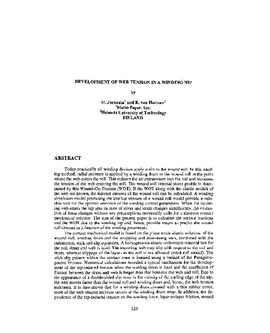| dc.contributor.author | Jorkama, M. | |
| dc.contributor.author | von Hertzen, R. | |
| dc.contributor.other | International Conference on Web Handling (2001) | |
| dc.date.accessioned | 2019-11-08T18:58:54Z | |
| dc.date.available | 2019-11-08T18:58:54Z | |
| dc.date.issued | 2001-06 | |
| dc.identifier | oksd_icwh_2001_jorkama | |
| dc.identifier.citation | Jorkama, M., & von Hertzen, R. (2001, June). Development of web tension in a winding nip. Paper presented at the Sixth International Conference on Web Handling (IWEB), Stillwater, OK. | |
| dc.identifier.uri | https://hdl.handle.net/11244/321815 | |
| dc.description.abstract | Today practically all winding devices apply a nip to the wound roll. In this winding method, radial pressure is applied by a winding drum to the wound roll at the point where the web enters the roll. This reduces the air entrainment into the roll and increases the tension of the web entering the roll. The wound roll internal stress profile is determined by this Wound-On-Tension (WOT). If the WOT along with the elastic moduli of the web are known, the internal stresses of the wound roll can be calculated. A winding simulation model predicting the internal stresses of a wound roll would provide a valuable tool for the optimal selection of the winding control parameters. When the incoming web enters the nip area its state of stress and strain changes significantly. An evaluation of these changes without any presumptions necessarily calls for a rigorous contact mechanical solution. The aim of the present paper is to calculate the surface tractions and the WOT due to the winding nip and, hence, provide means to predict the wound roll stresses as a function of the winding parameters. | |
| dc.description.abstract | The contact mechanical model is based on the plane strain elastic solutions of the wound roll, winding drum and the wrapping and intervening web, combined with the indentation, stick and slip equations. A homogeneous elastic orthotropic material law for the roll, drum and web is used. The incoming web may slip with respect to the roll and drum, whereas slippage of the layers in the roll is not allowed (solid roll model). The stick-slip pattern within the contact zone is iterated using a variant of the Panagiotopoulos Process. Numerical calculations revealed a typical mechanism for the development of the nip-induced tension when the winding drum is hard and the coefficient of friction between the drum and web is larger than that between the web and roll. Due to the appearance of a double-sided slip zone in the vicinity of the trailing edge of the nip, the web moves faster than the wound roll and winding drum and, hence, the web tension increases, It is also shown that for a winding drum covered with a thin rubber cover, most of the web tension increase occurs at the winding drum wrap. In addition, the dependence of the nip-induced tension on the winding force, layer-to-layer friction, wound roll and winding drum radii, drum cover compliancy and the elastic constants of the web was studied numerically. The calculated results were in good qualitative agreement with the experimental ones. | |
| dc.format | application/pdf | |
| dc.language | en_US | |
| dc.publisher | Oklahoma State University | |
| dc.rights | In the Oklahoma State University Library's institutional repository this paper is made available through the open access principles and the terms of agreement/consent between the author(s) and the publisher. The permission policy on the use, reproduction or distribution of the article falls under fair use for educational, scholarship, and research purposes. Contact Digital Resources and Discovery Services at lib-dls@okstate.edu or 405-744-9161 for further information. | |
| dc.title | Development of web tension in a winding nip | |
| osu.filename | oksd_icwh_2001_jorkama.pdf | |
| dc.type.genre | Conference proceedings | |
| dc.type.material | Text | |
